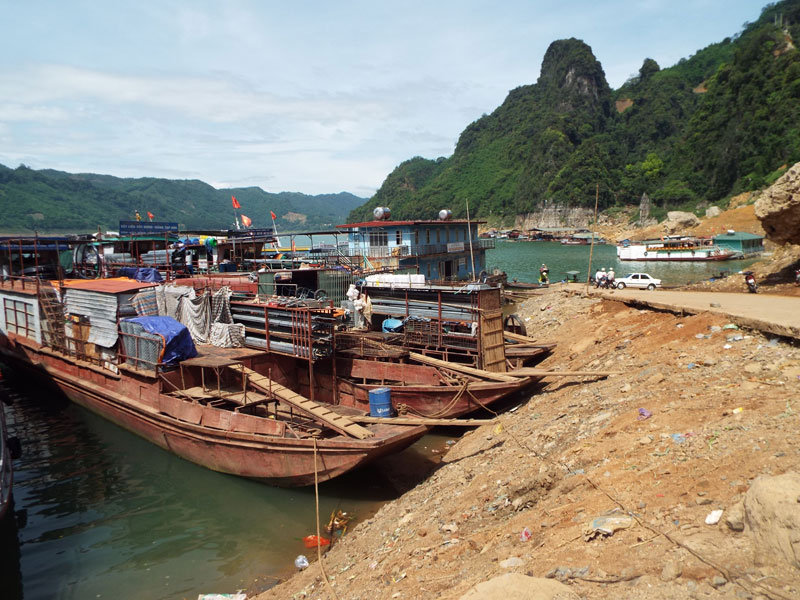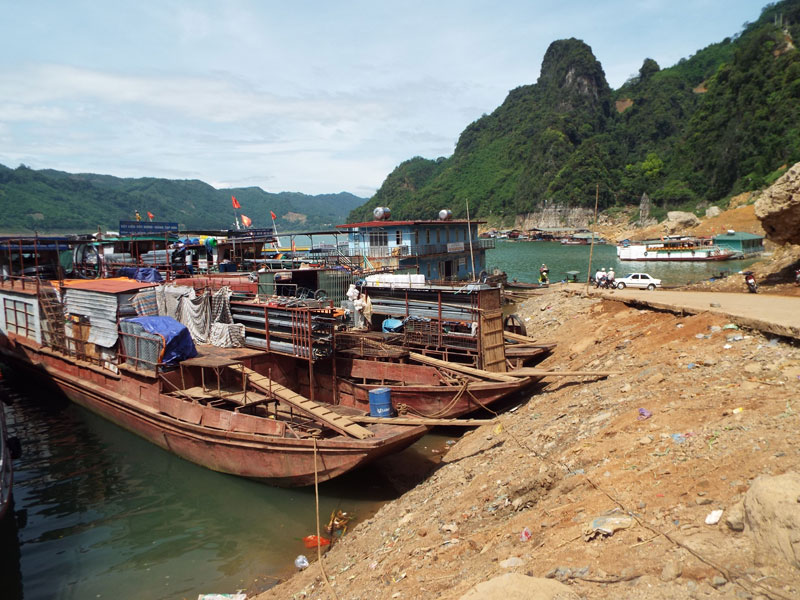
(HBO) – Bich Ha Port, located in the left bank of Hoa Binh Lake in Thai Thinh commune of Hoa Binh city, is one of the important facilities serving the transportation of goods from the city to communes bordering the lake and Son La province.
However,
the port’s infrastructure has degraded after years of being used. Without a
dock, tourists still have to move along natural paths, which is unsafe.
Meanwhile, boats carrying goods and tourists haven’t had their own areas to
operate at the port.

In the province’s port development plan until 2020,
Bich Ha Port will be upgraded to meet the requirements for the Hoa Binh Lake area
to become a national tourism site.
Problems of ports and wharves along the Da River
will be addressed soon when the provincial People’s Committee issued a plan on
the development of local ports until 2020. Bich Ha Port is set to be upgraded
to serve both goods and tourist transportation when Hoa Binh Lake becomes a national
tourism site.
Nguyen Ba Nhu, head of the transportation
division at the provincial Department of Transport, said the Prime Minister’s
approval of a plan on building the Hoa Binh Lake National Tourism Site is a big
favourable condition for Hoa Binh province to tap its tourism potential.
On May 31, 2017, the provincial People’s
Committee approved a development plan for inland ports in Hoa Binh until 2020.
Accordingly, some existing ports will be improved while three ports in the
downstream area of the Hoa Binh hydropower plant will be developed. Of which, Hoa
Binh Port in the right bank of the Da River will specialise in loading goods.
Another specialised port will be developed in the left bank of the Da River,
where a cement factory used to be located. The third port in Thinh Lang ward
will serve mixed purposes.
While Bich Ha Port will be upgraded to cater for
both goods and tourist transportation, Thung Nai Port will be expanded to serve
tourism. Some wharves are also expected to gain a facelift such as Binh Thanh
(Cao Phong district), and Bai Sang and Phuc San (Mai Chau district).
Provincial authorities are devising a plan to
balance resources for infrastructure investment so as to attract businesses to
developing tourism products for the future national tourism site of Hoa Binh
Lake./.
Da Bac district has pinpointed culture as a key driver of tourism development, a direction clearly outlined in the Resolution of the 25th district Party Congress for the 2020-2025 tenure.
Go Lao waterfall in Go Mu hamlet, Son Thuy commune, Mai Chau district is a hidden gem of the northern mountainous province of Hoa Binh.
In the first 9 months of 2024, Hoa Binh province continues to implement the expanded tourism development cooperation program plan of 8 Northwest provinces with Ho Chi Minh City; deploying digital transformation content in tourism and developing a smart tourism province. Hoa Binh province received about 3.6 million views, an increase of 7.9% over the same period. In which, international visitors are about 380 visitors, domestic visitors are estimated at 3 million 220 visitors.
Spanning thousands of hectares and winding gracefully along mountain slopes, hillsides, and riverbanks, the terraced rice fields of Lac Son District present a stunning and captivating beauty. This region, renowned for its remarkable terraced landscapes, is also the centre of Hoa Binh Culture known for numerous archaeological sites.
The life of Mong people in Hang Kia and Pa Co communes of Mai Chau district has improved much thanks to tourism development.
The man-made Hoa Binh Lake, with a water surface area of approximately 9,000 hectares and a capacity of 9.45 billion cubic meters, stretches over 200 kilometers from Hoa Binh to Son La provinces. With the goal of developing into a national tourism area, the Hoa Binh Lake tourism area is expected to not only become the largest tourism centre in the province but also one of the 12 key tourist destinations in the northern midland and mountainous region of Vietnam.



